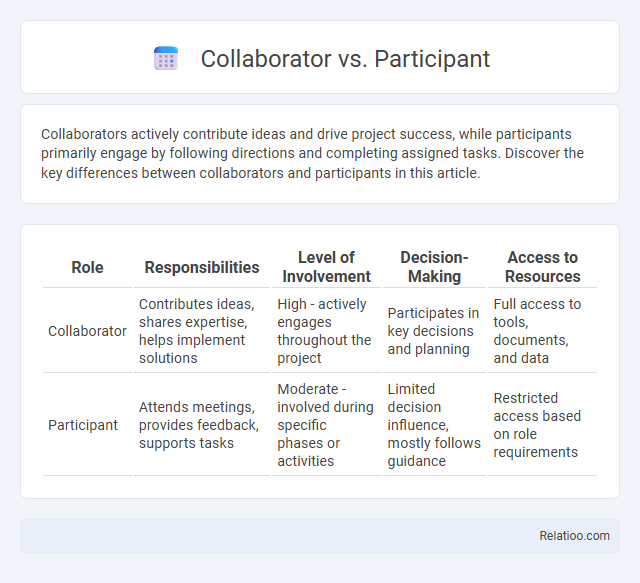Collaborators actively contribute ideas and drive project success, while participants primarily engage by following directions and completing assigned tasks. Discover the key differences between collaborators and participants in this article.
Table of Comparison
| Role | Responsibilities | Level of Involvement | Decision-Making | Access to Resources |
|---|---|---|---|---|
| Collaborator | Contributes ideas, shares expertise, helps implement solutions | High - actively engages throughout the project | Participates in key decisions and planning | Full access to tools, documents, and data |
| Participant | Attends meetings, provides feedback, supports tasks | Moderate - involved during specific phases or activities | Limited decision influence, mostly follows guidance | Restricted access based on role requirements |
Understanding Collaborators and Participants
Understanding collaborators and participants is essential for effective project management and research design. Collaborators actively engage by contributing expertise and resources to achieve shared goals, while participants primarily provide data or insights without involvement in decision-making processes. Recognizing the distinct roles helps you allocate responsibilities accurately and optimize team dynamics for successful outcomes.
Key Differences Between Collaborators and Participants
Collaborators actively contribute ideas, skills, and resources to achieve shared goals, while participants primarily engage by attending and responding to activities without a direct role in decision-making or content creation. Collaborators often share responsibilities and have a stake in the project's outcomes, whereas participants have a more passive role, typically limited to observation or feedback. Understanding these distinctions helps you design effective teamwork by assigning roles that align with each individual's involvement level and impact.
Defining Roles: Collaborator vs Participant
Defining roles in team dynamics distinguishes a collaborator as an active contributor who shares responsibility and engages in decision-making, while a participant typically plays a more passive role, following guidance without significant input. Collaborators drive project innovation and outcomes through shared expertise and accountability, whereas participants often support tasks without assuming leadership or strategic influence. Clear differentiation ensures effective communication, resource allocation, and project success by aligning expectations with each role's level of involvement.
Responsibilities of a Collaborator
A Collaborator assumes active ownership of project tasks, driving strategic planning, resource allocation, and ensuring deliverables meet quality standards. Participants contribute by engaging in assigned roles without overarching accountability, often providing support or feedback. Collaborators coordinate team efforts, manage communications, and maintain progress oversight, making their responsibilities critical to project success.
Responsibilities of a Participant
A Participant in a project is primarily responsible for actively engaging in assigned tasks, providing timely feedback, and adhering to project guidelines to ensure progress. Your role as a Participant involves clear communication with Collaborators and maintaining accountability for your deliverables. While Collaborators lead strategic decisions and facilitate coordination, Participants focus on executing actions that support common objectives.
Benefits of Being a Collaborator
Being a collaborator enhances access to shared resources, expertise, and innovation opportunities compared to participants who mainly engage without contributing to decision-making. Collaborators benefit from stronger influence in project direction, increased ownership of outcomes, and expanded networking potential within multidisciplinary teams. This active role fosters professional growth, improved credibility, and higher chances of long-term success in collaborative environments.
Advantages of Being a Participant
Being a participant offers direct engagement and firsthand experience in projects or research, allowing you to contribute insights without the extensive responsibilities of a collaborator. Participants benefit from learning opportunities and access to resources while maintaining flexibility and lower commitment levels. This role supports personal growth and skill development through observation and interaction within the team environment.
Choosing the Right Role for Your Project
Choosing the right role for your project depends on understanding the distinct contributions of collaborators, participants, and observers. Collaborators actively contribute ideas and work towards common goals, while participants provide input or feedback without direct responsibility for outcomes. Your project's success hinges on clearly defining these roles to align expertise and commitment with each phase of the work.
Common Misconceptions: Collaborator vs Participant
Common misconceptions confuse collaborators and participants, though their roles differ significantly in project dynamics. A collaborator actively contributes expertise and decision-making, driving project outcomes, while a participant primarily observes or engages without substantial influence. Understanding these distinctions clarifies your role and expectations, ensuring effective teamwork and communication.
Best Practices for Effective Collaboration and Participation
Effective collaboration involves clear role definitions, where collaborators contribute expertise and resources while participants engage actively to provide feedback and ideas. Best practices include establishing transparent communication channels, setting shared goals, and fostering mutual respect to ensure productive teamwork. Utilizing collaboration tools and regular check-ins enhances accountability and alignment among collaborators and participants alike.

Infographic: Collaborator vs Participant
 relatioo.com
relatioo.com